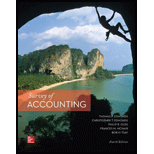
a.
Ascertain the
a.
Explanation of Solution
Return on investment (ROI): This financial ratio evaluates how efficiently the assets are used in earning income from operations. So, ROI is a tool used to measure and compare the performance of a units or divisions of companies.
Formula of ROI:
Ascertain the ROI of Segment EA for the years 2010 and 2011.
| Particulars |
2010 (in millions) |
2011 (in millions) |
| Income before taxes (a) | $1,000 | $1,089 |
| Identifiable operating assets (b) | $1,278 | $1,245 |
| Return on Investment | 78.25% | 87.47% |
Table (1)
Ascertain the ROI of Segment E for the years 2010 and 2011.
| Particulars |
2010 (in millions) |
2011 (in millions) |
| Income before taxes (a) | $3,020 | $3,134 |
| Identifiable operating assets (b) | $2,724 | $3,204 |
| Return on Investment | 110.87% | 97.82% |
Table (2)
Ascertain the ROI of Segment LA for the years 2010 and 2011.
| Particulars |
2010 (in millions) |
2011 (in millions) |
| Income before taxes (a) | $2,426 | $2,832 |
| Identifiable operating assets (b) | $2,298 | $2,446 |
| Return on Investment | 105.57% | 115.78% |
Table (3)
Ascertain the ROI of Segment NA for the years 2010 and 2011.
| Particulars |
2010 (in millions) |
2011 (in millions) |
| Income before taxes (a) | $1,523 | $2,325 |
| Identifiable operating assets (b) | $32,793 | $33,422 |
| Return on Investment | 4.64% | 6.96% |
Table (4)
Ascertain the ROI of Segment P for the years 2010 and 2011.
| Particulars |
2010 (in millions) |
2011 (in millions) |
| Income before taxes (a) | $2,049 | $2,154 |
| Identifiable operating assets (b) | $1,827 | $2,085 |
| Return on Investment | 112.15% | 103.31% |
Table (5)
Analysis: Of all segments, Segment LA has performed well in 2011, with the highest ROI of 115.78%. The ROI of Segment LA has improved from 2010 to 2011.
b.
Ascertain the residual income for each of the geographical segments of Company CC for the years 2011 and 2010. Identify the segment that has performed well in 2011, based on the residual income, and also identify the segment that has improved from 2010 to 2011.
b.
Explanation of Solution
Residual income: Residual income is the excess of income over the minimum acceptable return on average capital invested. The minimum
Ascertain the residual income for each of the geographical segments of Company CC for the years 2010 (amount in millions).
| Residual income for 2010 | |||||
| Particulars | Geographical Segments | ||||
| EA | E | LA | NA | P | |
| Income before taxes (A) | $1,000 | $3,020 | $2,426 | $1,523 | $2,049 |
| Identifiable operating assets (B) | $1,278 | $2,724 | $2,298 | $32,793 | $1,827 |
| Minimum rate of return at 30% | 30% | 30% | 30% | 30% | 30% |
| Residual income for 2010 | $617 | $2,203 | $1,737 | ($8,315) | $1,501 |
Table (6)
Ascertain the residual income for each of the geographical segments of Company CC for the years 2011 (amount in millions).
| Residual income for 2011 | |||||
| Particulars | Geographical Segments | ||||
| EA | E | LA | NA | P | |
| Income before taxes (A) | $1,089 | $3,134 | $2,832 | $2,325 | $2,154 |
| Identifiable operating assets (B) | $1,245 | $3,204 | $2,446 | $33,422 | $2,085 |
| Minimum rate of return at 30% | 30% | 30% | 30% | 30% | 30% |
| Residual income for 2010 | $716 | $2,173 | $2,098 | ($7,702) | $1,529 |
Table (7)
Analysis: Of all segments, Segment E has performed well in 2011, with the highest residual income of $2,173 million, and in 2010, with highest residual income of $2,203 million. On the basis of residual income, Segment LA has improved the most from 2010 to 2011 with an increase of $361 million
c.
Explain the reason for the segment with highest ROI in 2011 but was not the segment with highest residual income.
c.
Explanation of Solution
Of all segments, Segment LA had the highest ROI of 115.78% in 2011, but it was not the segment with highest residual income.
Reason: Residual income depends on the value of operating assets. Since Segment E had more operating assets than Segment LA, the residual income of Segment LA was lower in 2011, despite of highest ROI.
d.
Indicate the segment that stands as the best investment opportunity for Company CC, and give reasons.
d.
Explanation of Solution
Best investment opportunity: Segment LA would be the best segment for the investment opportunity for Company CC, based on the ROI. Company CC should consider the non-quantitative factors too, before investing in Segment LA.
Want to see more full solutions like this?
Chapter 15 Solutions
Loose-Leaf for Survey of Accounting

 AccountingAccountingISBN:9781337272094Author:WARREN, Carl S., Reeve, James M., Duchac, Jonathan E.Publisher:Cengage Learning,
AccountingAccountingISBN:9781337272094Author:WARREN, Carl S., Reeve, James M., Duchac, Jonathan E.Publisher:Cengage Learning, Accounting Information SystemsAccountingISBN:9781337619202Author:Hall, James A.Publisher:Cengage Learning,
Accounting Information SystemsAccountingISBN:9781337619202Author:Hall, James A.Publisher:Cengage Learning, Horngren's Cost Accounting: A Managerial Emphasis...AccountingISBN:9780134475585Author:Srikant M. Datar, Madhav V. RajanPublisher:PEARSON
Horngren's Cost Accounting: A Managerial Emphasis...AccountingISBN:9780134475585Author:Srikant M. Datar, Madhav V. RajanPublisher:PEARSON Intermediate AccountingAccountingISBN:9781259722660Author:J. David Spiceland, Mark W. Nelson, Wayne M ThomasPublisher:McGraw-Hill Education
Intermediate AccountingAccountingISBN:9781259722660Author:J. David Spiceland, Mark W. Nelson, Wayne M ThomasPublisher:McGraw-Hill Education Financial and Managerial AccountingAccountingISBN:9781259726705Author:John J Wild, Ken W. Shaw, Barbara Chiappetta Fundamental Accounting PrinciplesPublisher:McGraw-Hill Education
Financial and Managerial AccountingAccountingISBN:9781259726705Author:John J Wild, Ken W. Shaw, Barbara Chiappetta Fundamental Accounting PrinciplesPublisher:McGraw-Hill Education





